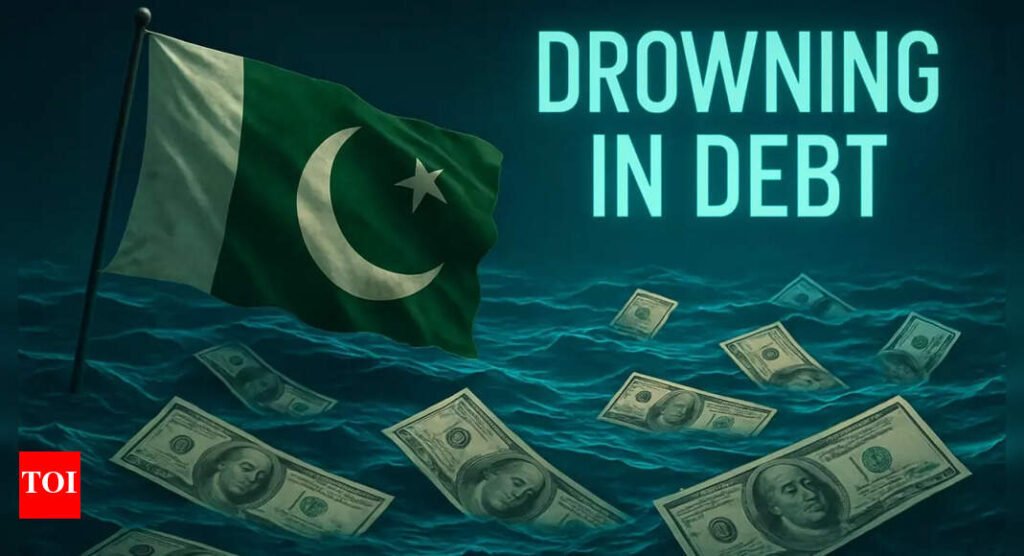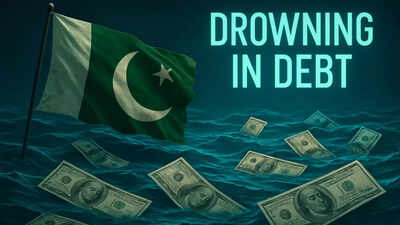
Pakistan’s economy is deeply troubled, and its drowning in debt – its dependency on external support increasing every year. Pakistan got a record $26.7 billion in foreign loans in the previous fiscal year – a fact that clearly highlights its growing reliance on multilateral and bilateral lenders.Approximately 50% of these borrowings comprised refinancing of existing loans, PTI quoted a report from The Express Tribune saying.
Pakistan’s Debt Trouble in Numbers
- Pakistan’s foreign exchange reserves of $14.5 billion at end-June consist primarily of refinanced loans, rollovers and new borrowings. This situation demonstrates the country’s increasing dependence on external lenders, which poses risks to economic stability, the PTI report said.
- The fiscal year 2024-25 saw disbursements of $26.7 billion, which is a marginal increase from the previous fiscal period, according to combined data from the Ministry of Economic Affairs, the State Bank of Pakistan (SBP) and the Ministry of Finance.
- Pakistan’s Ministry of Economic Affairs has said that of the total $26.7 billion foreign loans, roughly 13% or only $3.4 billion has been allocated for project financing.
- This small allocation towards project financing is indicative of the repayment challenges plaguing
Pakistan economy . The majority of foreign borrowings at present support budgetary needs and foreign exchange reserves, neither of which generate funds for debt servicing. - According to the Ministry of Finance, Pakistan’s current debt-to-GDP ratio and gross financing requirements as a proportion of GDP have surpassed sustainable thresholds.
- When gross financing requirements exceed 15% of GDP, it indicates an unsustainable position. Based on the Ministry of Finance’s earlier estimates, Pakistan is expected to remain above this critical level for a minimum of three years ahead
Also Read | Real economic blow to Pakistan! India chokes $500 million Pakistani goods entering it via third countries
Who Is Giving Loans to Pakistan?
The Ministry of Economic Affairs has booked $11.9 billion in federal government accounts, exceeding the previous fiscal year by $1.2 billion. Whilst the IMF provided $2.1 billion, an additional $12.7 billion was secured through cash deposit rollovers from Saudi Arabia, China, the UAE, and Kuwait.Saudi Arabia has around $5 billion in cash deposits with the Pakistani central bank, with a 4% interest rate on the loans. These deposits have annual rollovers, because Pakistan is unable to repay. Even the IMF’s three-year programme assumes a continuous rollover of the $12.7 billion loans. This raises concerns about the sustainability of external sector stability.Chinese deposits amount to $4 billion, carrying an interest rate of more than 6%. Additionally, China provided $484 million in guaranteed loans during the last fiscal year, which were predominantly utilised for asset acquisitions.The UAE has placed $3 billion with the Pakistan central bank. The finance ministry got $4.3 billion in commercial loans, which is majorly made up of refinanced Chinese loans and additional borrowings which are backed by Asian Development Bank (ADB) guarantees.The ADB provided $2.1 billion in new loans, above the budget by $500 million. The total contribution from multilateral institutions was $6.9 billion.The World Bank provided $1.7 billion, falling $300 million below the planned allocation, whilst not declaring any fresh budget support funding for the ongoing fiscal period.The Islamic Development Bank released $716 million in funds, whilst Saudi Arabia extended $200 million through an oil financing arrangement at a steep 6 per cent interest rate, rendering it a costly borrowing option.Also Read | India bleeds Pakistan dry: Water at ‘dead’ levels in Pakistan’s dams; bigger Indus river plans in the works – top points to know
Pakistan’s Poor Global Picture
According to the PTI report, Pakistan was unable to access international capital markets during last financial year, and their planned borrowing of $1 billion through Eurobonds and Panda bonds did not succeed. The government and central bank resorted to obtaining costly foreign commercial loans, supported by multilateral guarantees, to address the funding gap.Due to Pakistan’s poor credit rating at junk level, the nation remains excluded from global capital markets and faces high interest rates for commercial loans and cash deposits.







